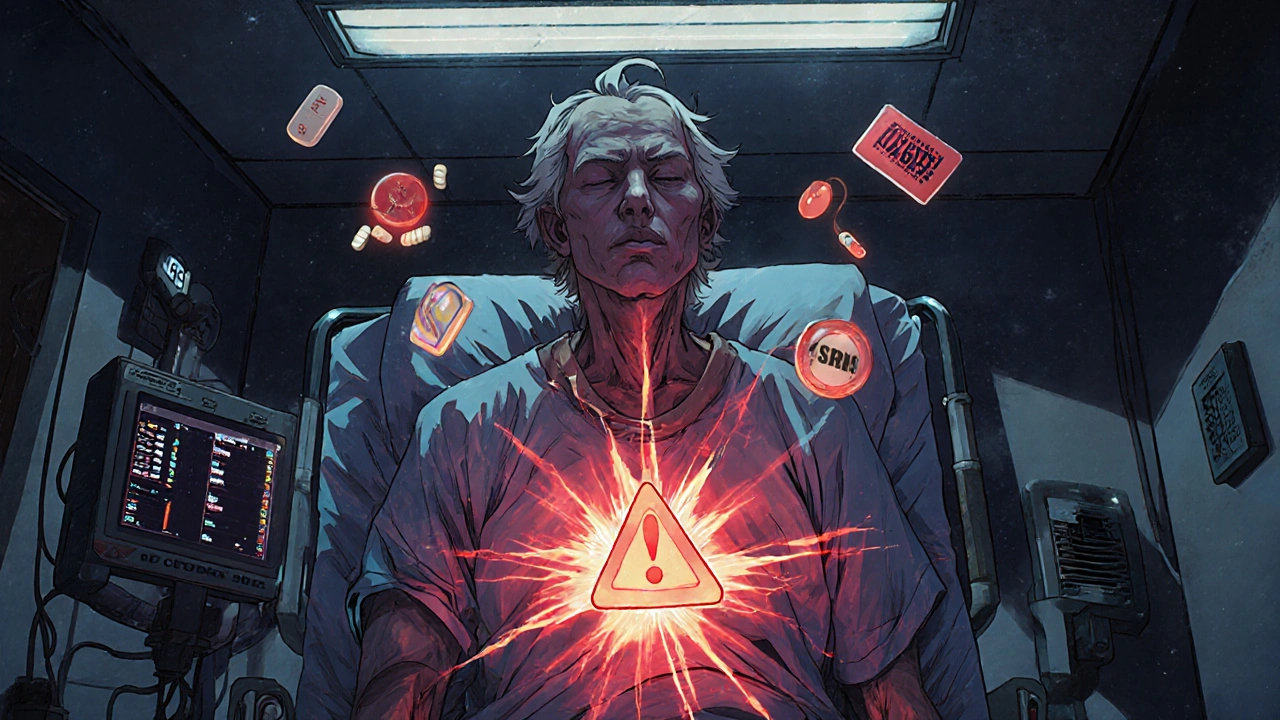
When you take two drugs at the same time, they don’t just sit there doing their own thing. Sometimes, they talk to each other-directly, at the cellular level-and change how one or both work. This isn’t about one drug slowing down the other’s absorption or metabolism. That’s pharmacokinetics. This is something deeper: pharmacodynamic drug interactions. It’s when one drug changes how another drug acts at its target site, even if the concentration of the drug in your blood hasn’t changed at all.
How Pharmacodynamic Interactions Work
Think of your body’s receptors like locks. Drugs are keys. A pharmacodynamic interaction happens when one key changes how another key fits-or even blocks-the lock entirely. You could have two drugs trying to turn the same lock. One might be a better fit, so it pushes the other out. Or both might turn the lock at the same time, making the effect stronger than either could do alone. Or one drug might lock the door completely, stopping the other from working no matter how much you try.
These interactions don’t depend on how much drug is in your bloodstream. They depend on what’s happening at the receptor. That’s why you can’t fix them by just changing the dose. If two drugs are fighting over the same receptor, lowering one dose won’t help if the other is still binding more tightly. You have to remove one.
The Three Main Types
There are three clear patterns to how drugs interact pharmacodynamically:
- Additive: The combined effect equals the sum of each drug’s individual effect. Take two painkillers that both work on the same pathway-like acetaminophen and a low-dose opioid. Together, they give you the pain relief you’d expect from adding their separate effects.
- Synergistic: The combined effect is stronger than the sum. This is where things get powerful-sometimes dangerously so. The antibiotic combo of trimethoprim and sulfamethoxazole works this way. Each blocks a different step in bacterial folic acid production. Together, they shut down the pathway completely, making the bacteria unable to survive. This synergy lets doctors use lower doses of each drug, reducing side effects while boosting effectiveness.
- Antagonistic: One drug blocks or reduces the effect of another. This is the most common and often the most dangerous type. Beta-blockers like propranolol can completely stop bronchodilators like albuterol from working by competing for the same beta-2 receptors in the lungs. In someone with asthma, this isn’t just inconvenient-it can be life-threatening.
Real-World Examples That Can Kill
Some pharmacodynamic interactions are so dangerous they’re listed as absolute contraindications. Here are a few that show up in hospital emergency rooms every week:
- SSRIs + MAOIs: Mixing antidepressants like sertraline with monoamine oxidase inhibitors (like phenelzine) can trigger serotonin syndrome. This isn’t a mild reaction. It causes high fever, muscle rigidity, seizures, and can lead to death. Studies show this combination increases serotonin syndrome risk by 24 times compared to using either drug alone.
- Opioids + Opioid Antagonists: Giving naloxone to someone dependent on morphine or oxycodone doesn’t just reverse the high-it triggers full-blown withdrawal. Rapid heart rate, vomiting, sweating, panic. In a hospital setting, this can destabilize a patient who’s already fragile.
- NSAIDs + ACE Inhibitors: Ibuprofen or naproxen may seem harmless alongside blood pressure meds like lisinopril. But NSAIDs block prostaglandins that help keep kidney blood flow stable. When you block those, ACE inhibitors lose up to 25% of their ability to lower blood pressure. Over time, this can lead to kidney damage, especially in older adults.
A 2020 analysis of FDA reports found that 68% of serious adverse events from pharmacodynamic interactions led to hospitalization-much higher than the 42% rate for pharmacokinetic interactions. Why? Because you can’t just adjust a dose. You have to stop one drug entirely.

When Interactions Help-Not Hurt
Not all pharmacodynamic interactions are bad. Medicine uses them on purpose. The combination of naltrexone and low-dose antidepressants for treatment-resistant depression is one example. In a 12-week trial with 142 patients, 68% saw significant improvement when naltrexone was added-compared to just 42% on antidepressants alone. Naltrexone, an opioid receptor blocker, seems to reset how the brain responds to mood-regulating chemicals. It’s not fully understood, but it works.
Another example: combining low-dose aspirin with clopidogrel for heart attack prevention. Both prevent platelets from clumping, but through different pathways. Together, they’re more effective than either alone. That’s why cardiologists prescribe them together-but only for specific patients. Too many people on both can bleed out.
Who’s at Risk?
Anyone taking more than three medications is at higher risk. But some groups are especially vulnerable:
- Elderly patients: The average 70-year-old takes 4.8 prescription drugs. Many of these are for chronic conditions-high blood pressure, diabetes, arthritis-all of which involve drugs with narrow therapeutic windows.
- People with kidney or liver disease: Even if a drug’s concentration isn’t changing, their bodies handle stress and recovery less efficiently. A small drop in blood pressure from an NSAID can cause acute kidney injury.
- Patients on narrow therapeutic index drugs: These are drugs where the difference between a helpful dose and a toxic one is tiny. Think warfarin, digoxin, lithium, or phenytoin. A 10% change in effect can mean the difference between control and crisis.
Studies show that 83% of life-threatening pharmacodynamic interactions involve at least one drug with a therapeutic index below 3.0. That’s why checking for these interactions isn’t optional-it’s critical.

Why Doctors Miss Them
Even with electronic health records and drug interaction checkers, mistakes happen. Why?
- Most systems flag pharmacokinetic interactions-like grapefruit juice slowing down metabolism-but ignore pharmacodynamic ones unless they’re extreme.
- Many clinicians don’t think about receptor-level interactions unless they’ve been trained specifically in pharmacology.
- Patients don’t always tell their doctors about over-the-counter drugs, supplements, or herbal remedies. St. John’s wort, for example, can reduce the effect of antidepressants by activating liver enzymes-but it also has direct effects on serotonin receptors, which most systems don’t track.
A 2022 survey of over 1,200 physicians found that 63% saw at least one dangerous pharmacodynamic interaction every month. The most common? Anticoagulants mixed with antiplatelets, or multiple CNS depressants like benzodiazepines, opioids, and sleep meds.
One pharmacist on Reddit shared a case where linezolid (an antibiotic) and sertraline (an antidepressant) caused serotonin syndrome in an elderly woman. She ended up in intensive care for three days. The interaction wasn’t flagged by the hospital’s software because it was considered “rare.” But it’s not rare enough to ignore.
How to Stay Safe
There’s no magic tool that catches every interaction. But you can reduce your risk:
- Know your meds. Don’t just take what’s on the label. Ask: What does this drug do? What does it affect? Is it meant to calm me down, wake me up, lower my blood pressure, or block pain?
- Use trusted resources. The University of Liverpool’s HIV Drug Interactions database is widely used by specialists. For broader use, the FDA’s drug interaction database and Micromedex are reliable.
- Ask for a medication review. A pharmacist-led review cuts adverse events from drug interactions by 58% in older adults, especially when it comes to NSAIDs and antihypertensives.
- Watch for signs. If you start feeling dizzy, confused, overly sleepy, or your blood pressure suddenly drops after starting a new drug, it might not be the drug itself-it might be how it’s interacting.
The Future of Managing These Interactions
Technology is catching up. The FDA now requires pharmacodynamic interaction studies for all new CNS drugs. The European Medicines Agency reports that 34% of new drug applications now include this data-up from 19% in 2015. Researchers at UCSF have built a machine learning model that predicts serotonin syndrome risk with 89% accuracy by analyzing a patient’s full drug list.
Health systems are testing real-time alerts in electronic records. The UK’s NHS is piloting a system that flags dangerous combinations as soon as a prescription is written. It’s not perfect yet-but it’s moving in the right direction.
For now, the best defense is knowledge. Understanding that drugs don’t just act in isolation-that they can team up, cancel each other out, or turn a helpful treatment into a danger-is what keeps patients safe. It’s not just about what’s in the bottle. It’s about how the body responds when two bottles are opened at the same time.
What’s the difference between pharmacodynamic and pharmacokinetic drug interactions?
Pharmacokinetic interactions affect how the body processes a drug-like absorption, metabolism, or excretion. For example, grapefruit juice slows down how fast your liver breaks down statins, raising their blood levels. Pharmacodynamic interactions happen at the target site-like receptors or enzymes-and change how the drug works, even if its concentration stays the same. One drug can block another’s effect at the receptor, or make it stronger, without changing how much of it is in your blood.
Can I avoid pharmacodynamic interactions by taking drugs at different times?
No. Timing doesn’t help with pharmacodynamic interactions because they don’t depend on drug concentration in your bloodstream. If two drugs compete for the same receptor, taking them hours apart won’t stop them from interacting. The drug that binds more tightly will still dominate the receptor, regardless of when you took the other. Avoiding the combination is the only reliable solution.
Are over-the-counter drugs and supplements capable of pharmacodynamic interactions?
Yes. St. John’s wort can directly affect serotonin receptors, reducing the effectiveness of antidepressants. NSAIDs like ibuprofen can block the blood pressure-lowering effects of ACE inhibitors. Even common supplements like garlic or ginkgo can interfere with blood clotting mechanisms, increasing bleeding risk when taken with aspirin or warfarin. Always tell your doctor what you’re taking-even if it’s “natural.”
Why are pharmacodynamic interactions harder to detect than pharmacokinetic ones?
Most drug interaction checkers are built to catch changes in drug levels-like when one drug inhibits liver enzymes. Pharmacodynamic interactions don’t change blood concentrations, so they’re invisible to these tools. They require clinical knowledge: understanding receptor biology, physiological pathways, and how drugs affect body systems. That’s why even experienced prescribers can miss them.
Can pharmacodynamic interactions be predicted before prescribing?
Yes, but not perfectly. Researchers are using machine learning to analyze drug-receptor binding data, physiological pathways, and patient history to predict risks like serotonin syndrome with over 85% accuracy. Still, no system catches everything. The most reliable approach combines clinical decision support tools with a prescriber’s understanding of pharmacology-especially for patients on multiple drugs or those with narrow therapeutic index medications.

kshitij pandey
November 15, 2025 AT 08:34Wow, this is such a clear breakdown! I work in a clinic in Delhi and see this all the time-people mixing ayurvedic herbs with blood pressure meds and wondering why they feel dizzy. No one tells them these interactions aren’t just ‘natural’-they’re real, and dangerous. Thanks for explaining it like we’re all just trying to stay alive.